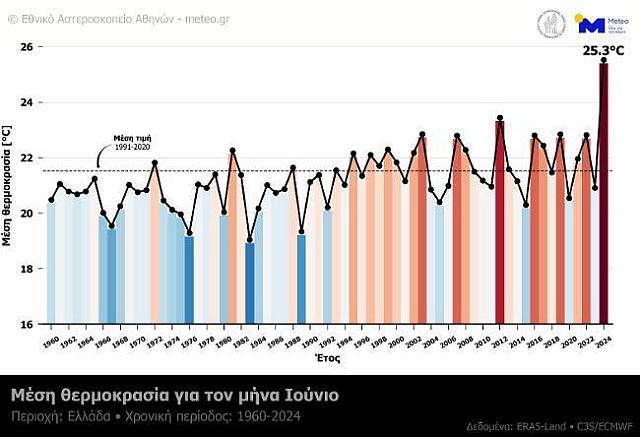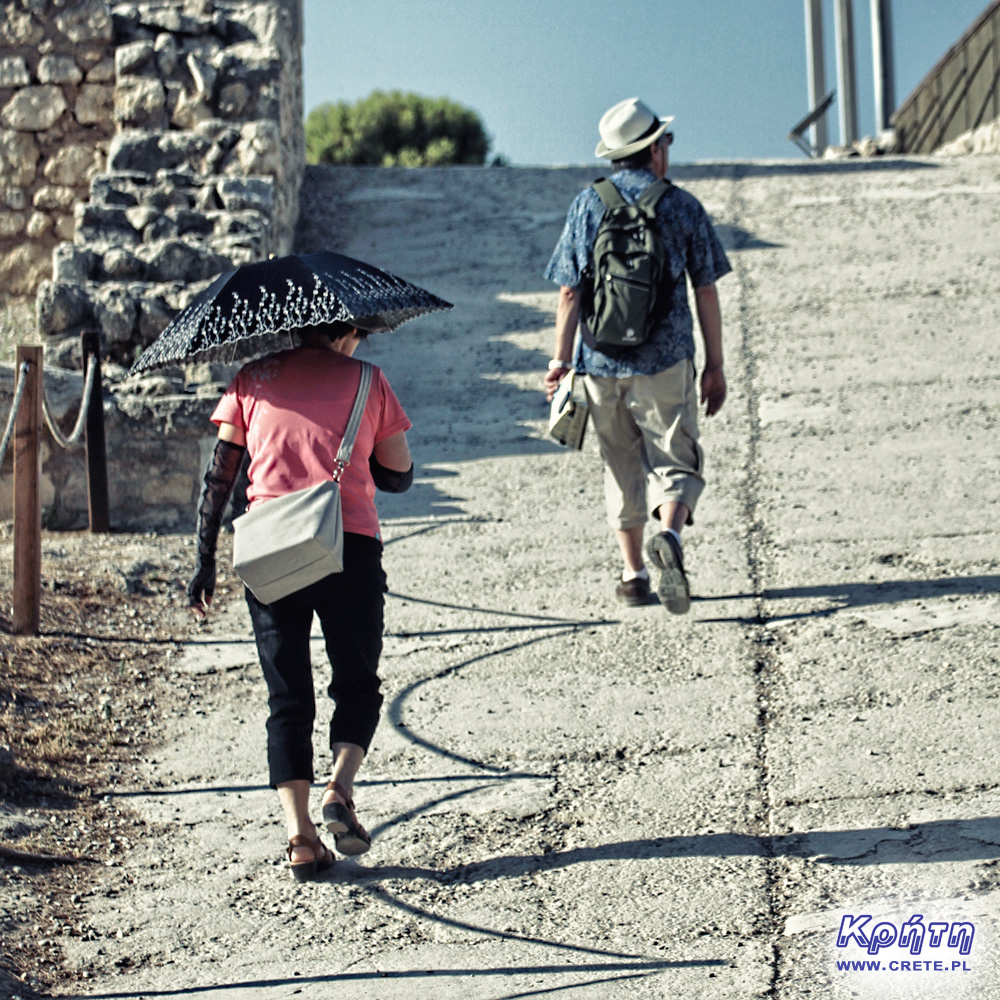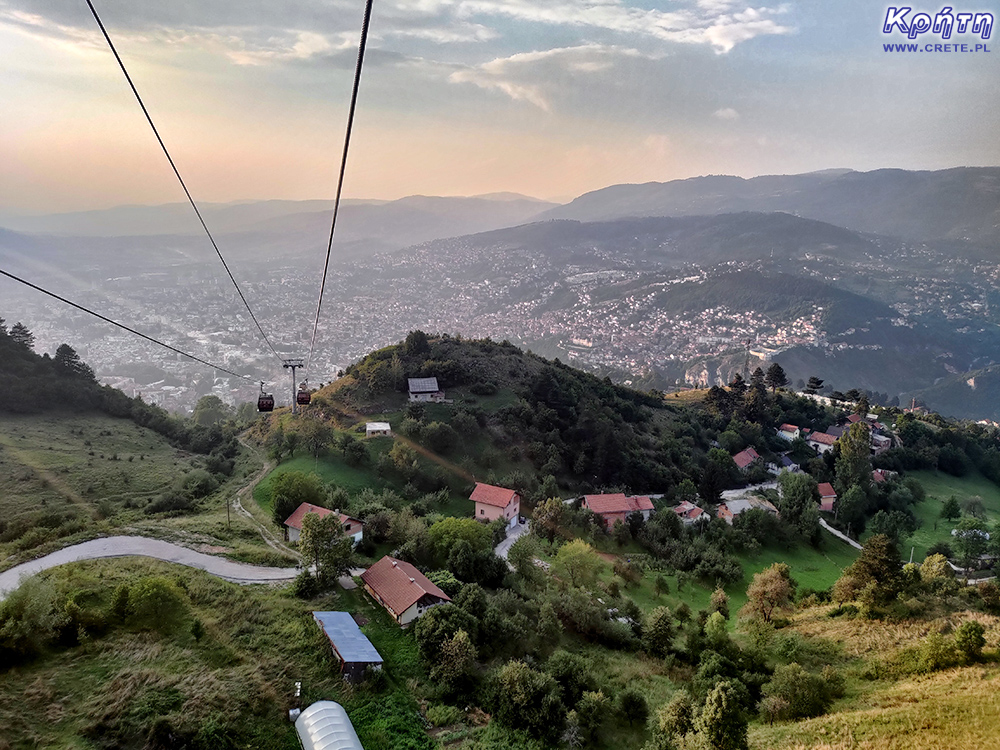
 2024-07-06 20:48:10
2024-07-06 20:48:10
Preliminary meteorological data analyzed by scientists from the National Observatory in Athens show that June 2024 in Greece was the warmest since 1960. The recorded temperatures exceeded the average temperature value for the period 1991-2020 by as much as 3.8 degrees C. The trend of average temperature in Greece from 1960 to 2024 during June indicates an increase of 2.5 degrees.
This is the second year in a row that Greece is experiencing climate change. Their effect is not only higher temperatures or more frequent fires. Last year, too high temperatures and a long-lasting drought caused many regions of the country, including Crete, to experience a huge decline in olive oil production. Everything indicates that this year will bring only a slightly higher production result. Local vineyards are also starting to experience problems. This year, the damage to Cretan vineyards will reach up to 70%, and in some areas the vines have even been completely destroyed.

Meanwhile, another problem lurks just around the corner. Southern European countries such as Spain, Italy and Greece have been a favorite summer destination for years. Offering not only extraordinary beaches and warm seas, but also historical and cultural attractions, they attract a wide range of tourists. However, extreme for Europe, long-lasting waves of temperatures exceeding even 40 degrees have prompted many people to reconsider their holiday plans. The tourism industry is now slowly starting to notice the first symptoms of changes in travel preferences.
Only in Crete, despite the first forecasts showing that this season will be even better than the previous one, the number of reservations is no longer growing as expected. Additionally, reports of new fires on the Greek islands that appear every now and then are another factor that favors a change in holiday direction. The feeling of danger and the possibility of interrupting your holiday if you need to evacuate may discourage many people from choosing the south of Europe as their holiday destination.

Although, according to the European Travel Commission, a record percentage of Europeans are still planning to travel to southern Europe between June and November, more and more people admit that they take climate change into account when choosing their holiday destination. The most important factor here is the possibility of too high temperatures. In the conducted research, as many as 34% of surveyed Europeans indicated that they avoid destinations where temperatures become too high and extreme weather phenomena occur. Instead, it will choose destinations with stable weather. Such a change in holiday habits is declared primarily by people over 55 years of age. Although 11% of people aged 18-24 also admit that too high temperatures will make them make a different choice for their holiday. Already 8.5% of respondents confirmed choosing other months for a holiday trip.

All this means that in the summer the popularity of destinations in northern Europe begins to increase, where lower temperatures allow you to freely engage in outdoor activities without the risk of exposure to extreme heat.
Although the change in trends is slow for now, it cannot be ignored. Climate change is progressing, so every year there will be more and more people choosing other holiday destinations. Changing travel preferences on a larger scale in the future could bring significant economic impacts for countries. Traditional destinations in the south may experience a decline in tourism revenues, while countries in the north of the continent, seeing increased interest, will start investing in new tourist infrastructure. The entire tourism industry will also begin to adapt to changing standards. Travel agencies and airlines will develop new offers that they will promote as a cooler alternative to the hot summer months.
 2024-07-06 20:48:10
2024-07-06 20:48:10
Komentarze
komentarz z
Za to lipiec pogoda bajka, okolice Milatos ok 30 stopni. Tymczasem wczoraj w Trójmieście temperatura późnym wieczorem była niemalże identyczna jak tu
komentarz z
Gracjana Bakuniewicz Wkrótce to się zmieni. Nadchodzący tydzień znowu ma przynieść na południu Europy temperatury około 40 stopni.
Pierwszy raz byliśmy na Krecie w 2008 - we wrześniu. Było przyjemnie - ale po 20 września zaczęły się chmury i deszcz. Po roku postanowiliśmy pojechać w czerwcu - w drugim i trzecim tygodniu. Drugi był przyjemny śle w trzecim jak powiało z południa zrobiło się za gorąco. Od tego czasu zaczęliśmy jeździć na przełomie maja i czerwca i we wrześniu - nasze dzieci były już na tyle duże że jeździły same. Byliśmy 18 razy na Krecie i 11 na innych wyspach w okresie od połowy marca do przełomu mają /czerwca i we wrześniu , gdybyśmy musieli z jakiegoś powodu pojechać w lipcu lub w sierpniu to wyspami branymi pod uwagę nie byłyby wyspy greckie, włoskie czy hiszpańskie a Hebrydy, Lofoty czy Wyspy Owcze. W tym roku mamy jeszcze w planie wyjazd 6 września do Grecji - ale zaczynam mieć wątpliwości czy był to dobry pomysł. Jak będzie gorąco to od przyszłego roku zaczniemy jeździć co najmniej po 15 września.
inne spojrzenie
1. W 2006 r. Rodos w sierpniu (30 stopni z wietrzykiem) był odpoczynkiem od polskiego lipcowego upału (35 nierzadko w duzym mieście)
2. Trzecia dekada sierpnia 2009 r. - Kreta - hotel przy plaży i niepotrzebna klima
3. Lipiec 2022 r. - Kos - upał ale na plązy wiaterek
Wszystko zasługą meltemi.
W dwóch punktach na trzy powołujesz się na przypadkowe pojedyncze dane sprzed 18 i 15 lat. My też możemy powiedzieć że w 2008 roku w Stalidzie przez dwa tygodnie fajnie wiało i nie potrzebna była klima. Naukowcy z Obserwatorium w Atenach analizują jednak dużo więcej danych i podają średnie odnotowanych temperatur oraz trend.
Prognoza pogody na tydzień dla Samos: 38/28, 38/27, 36/26, 34/26, 35/25, 36/26. ( dzień/ noc ) Wiatr 15- 20 km/ h. Powodzenia!!!
Do crete - to nie są przypadkowe dane
Lubię wyspy greckie za wiatr. Uważam pod tym względem - choć bardziej Rodos i Kos - za przypominające nieco Wyspy Kanaryjskie. Różnicę widać nawet jak się popłynie z Kos do Bodrum czy z Rodos do Marmaris.
Piszę natomiast o tym, że mimo wysokich temperatur łatwiej się je znosi jak jest wiaterek. Alanya czy Cypr to duchota przy wyspach greckich.
Zmiany klimatu są, np. w Heraklionie średnia roczna bywała w XX w. około 18 stopni. Teraz zwykle dany rok ma ponad 19.
https://en.tutiempo.net/climate/ws-167540.html
Też nie lubię jak ktoś "wie swoje" i jest mądrzejszy od naukowców :) ale nie o to mi chodziło
Wypełnij poniższy formularz aby dodać komentarz
lub kliknij w poniższy link aby skorzystać z możliwosci komentowania przez facebooka:
https://www.facebook.com/crete.poland/posts/870827115091554